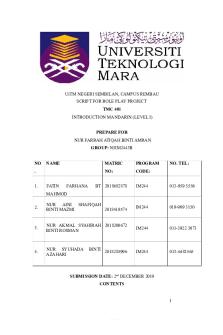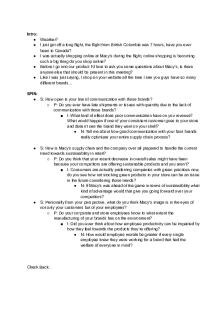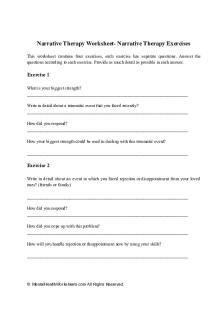Play therapy - notes PDF

| Title | Play therapy - notes |
|---|---|
| Author | Pauline Baker |
| Course | General Psychology |
| Institution | Suffolk University |
| Pages | 3 |
| File Size | 95.6 KB |
| File Type | |
| Total Downloads | 6 |
| Total Views | 156 |
Summary
notes...
Description
PLAY THERAPY Play was first used by FREUD in the treatment of “Little Hans”. Little Hans’ father recorded the child’s spontaneous behaviour, including talk, dreams and play. Freud saw the case in terms of his theory of emotional development, which predicts particular difficulties at given stages of development. For example, fear of horses, triggered by the real event of seeing a horse for under a load in the street, was taking to express covert anxiety about himself and his feelings towards his father, mother and the new baby. Hans’ play at being a horse, letting toy horses fall down etc., was seen not so much as fear at the memory of the original ‘Horse’ event, but fears and adjustments Hans was trying to cope with at the time. (I.e. real fear symbolised by association). MELANIE KLEIN started psychoanalysis of children in 1919. She considered direct education useless for the readjustment of emotionally disturbed (or maladjusted) children. She considered that disturbances would disappear only if the child was as a direct substitute for the verbal free association as used for Freud with adults. The assumption was that what the child does in free play symbolises the wishes, fears, pleasures, conflicts and preoccupations of which he is not aware. The therapist is seen to be in a special relationship with the child and acts as a kind of lay figure, the child assigning to her roles which have been made the focus of difficulties for the child in his real reactions to and feelings about other people. The therapist then tries to make the child aware of this by interpreting his play to him. She first used miniature toys, predominantly reproductions of family figures, for projective play. Like free association, a game played at a given moment can only be interpreted in the actual context of general play and what, at the time, proceeded and followed it. The therapist tries, within psychoanalytic theory, to understand what the child feels, and to convey this to him. For example, a child may play with bricks in such a way that individual bricks stand for people. (Perhaps members of the child’s family). If so, the therapist says so to the child (who may agree, deny or merely go on playing). It is from the manner of the assent, denial or subsequent play that the therapist infers whether her guess has been correct. (Over anxious acceptance of the suggested interpretation may disconfirm it as much as calm denial may. On the other hand, a violent or agitated denial may lead the therapist to suspect that the trail was ‘warm’, while being ignored may induce caution). Klein diverged from Freud in that she credited the child with “conscience” and guilt feelings towards the end of the first year, rather than after the age of 3. She also assumed an ability to symbolise objects at this age. (Symbolic activity is, in fact, seen at early ages). ANNA FREUD abided more by her father’s view, but modified it to adapt to children. Unlike Melanie Klein she considered child therapy radically different from the adult variety, for example, difficulties at home which might have originally produced the emotional disturbance may still be there. They must be ascertained, possibly manipulated, and improved. Since a child’s parents are probably still alive, it is not desirable to project the image of the parent onto the analyst. Analysis (i.e. uncovering and redirecting fixated libido by making the child aware of conflicts)is only one part of the therapy. The therapist’s job is also educational and for this he needs the child’s confidence and affection. According to Anna Freud play is not symbolic of anything (e.g. if a boy builds a lamp-post it could be simply because he has seen one which impressed him). Children do play fantasy games but the motives behind it have to be built up from evidence available about the child’s situation at home, current experiences and a knowledge of his wishes, hopes and fears, which can only be obtained with the child’s confidence and with familiarity. The above were the beginning of play therapy.
-1-
The Anna Freud tradition: Stresses the child’s relationship to the therapist 1. The Melanie Klein tradition: Depends more on interpretations to the child of his symbolic play 2. Some use play merely to communicate with a patient. 3. Some restrict the child to a few toys, encouraging him/her to re-enact particular scenes suspected or known to have been traumatic for him (said to be useful in dealing with phobias). In the early days Freud and followers concentrated on “conflicts of conscience” (anxiety over doing what is forbidden said to be learned so intensely that it extends to associated but permitted activities i.e. there is a severe superego repressing the id). More recently the child’s ability to respond to and cope with his environment has received more attention (the strength of the ego, which relates to the child’s impulse to “reality” – e.g. in learning to defer satisfaction of desires). 4. Most therapists use whatever ideas and techniques seem most appropriate in particular cases. E.g. LOWENFIELD’S “world picture” technique – using miniatures of people, animals, fences, houses, trees, bridges, etc., water and sand trays with three different kinds of sand. Child is told to play as he likes with them. The resulting “miniature world” may be mountains, valleys and scenery with people or animals, replicas of towns with neat rows of houses, fantasy with wild animals rushing all over the place or contain no animals or people at all. The child is then asked to explain the “world” he has built, from the point of view of an “ignorant Martian” and say what will happen next. Here, the context, style and amount of movement in what is happening are supposed to reveal the degree of the child’s disturbance and give some idea of what it was about. 5. Dramatic Play: acting out social situations with others is considered to have a “releasing” effect. For example, the child may learn to respond to others in drama, where they may not otherwise. Playing an adult they may learn the difficulties of an adult in coping with a fractious child. 6. Art therapy: Drawings and paintings are interpreted or used to express feelings. 7. Free play: no direction or interpretation from adults is held to cure emotional disturbance by “non directive” therapists. Here, the therapist’s role is seen as passive and limited to creating an atmosphere of friendliness and acceptance, hence enabling the patient to come to terms with his difficulties. It is assumed that the child will “act out” his conflicts and socially unacceptable impulses in play. (I.e. play is “cathartic”. It is assumed that a discharge of emotions through play in a secure atmosphere will reduce the child’s anxiety, after which he will be bale to adjust to normal social demands more easily. 8. Play techniques derived from Gestalt and Field Theories; these theories conceive personality development to consist of growing differentiations within the individual. Play is seen as the child’s method of exploring and coming to terms with the world. The adult, by sharing the child’s play and make-believe, reassures him of the validity and meaningfulness of what he does.
-2-
9. Learning Theory: Therapeutic processes (although not play specifically) as well as many psychoanalytic concepts, were translated into learning theory terms as instrumental learning by NEAL MILLER. Also MOWRER redescribed many of the hypotheses in terms of conditioning of autonomic responses (e.g. changes in breathing, heart rate, sweating, stomach contractions, etc. consequent upon excitement) as well as instrumental learning via rewards. Some of the ANS (Autonomic Nervous System) changes (i.e. involuntary accompaniments of anxiety and excitement like increased heart rate, palmar sweating and pupil dilation) persist long after a person’s outward behaviour has ceased to give any indication of it. They can then be aroused not merely by the original object of fear, but also by associated cues. For humans, words any symbols can arouse anxiety or excitement very effectively. 10. THE USE OF PLAY IN THERAPY Problems: How to assess the effects of therapy. 1. It is necessary to use a control group who do not receive the treatment to check the results. However, control groups only confer credibility if those who are treated and those who are not are matched as closely as possible e.g. for age, sex, I.Q., education and social standing of parents at least, and in the school they attend, the kind, number and severity of symptoms, how long they have shown disturbance, whether parents approve of treatment and temporary changes in a child’s environment must be taken into account. Hence matching is extremely difficult when comparing treatment groups with control groups. 2. Problem of how to define “success” and how to assess it. For example, if a “symptom” is that of being over aggressive without particular temper outbursts, being difficult to manage is general, unduly anxious and timid, without fear of a specific object. SEEMAN et al carried out an experimental study of children which cut through the difficulties of matching experimental and control groups by stimulating clinical conditions, rather than using an actual patient population. Sixteen children who had ranked lowest on various personality tests and behaviour ratings given to two age groups in a school, were then divided into two matched groups, only one of which received play therapy. Tests were given to both groups after a year and again after a further eighteen months. Significant differences were found between social adjustment scores, in favour of the treated group. However, this does not tell us much about what in particular brought about the changes. Until recently, play type therapy was the only kind of behaviour treatment for young children. Now, however, many therapies exist, using learning theory strategies. For example, classical and instrumental conditioning, gradual acclimatisation and aversion therapy. Bedwetting has been cured in older (not maladjusted) children through conditioning. For some child disturbances operant conditioning in terms of behaviour shaping is thought to be more successful. Play therapy Vs Behaviour Therapy: Play Therapy Conceived as a means of reorienting the child. Here the adult playing with the child does involve a continuous process of adult reactions to the child’s behaviour (attending to and playing with the child act as reinforcers). Behaviour Therapy Reinforcement is pre-arranged in the light of the knowledge of schedules of reinforcement, rather than being left to the judgement of the moment.
-3-...
Similar Free PDFs

Play therapy - notes
- 3 Pages

Play Therapy presentation
- 57 Pages

Reality Therapy Lecture Notes
- 7 Pages

6 TLDP therapy notes
- 3 Pages

IV Therapy Notes
- 8 Pages

ROLE PLAY TMC401 - role play
- 10 Pages

Family therapy notes pg 373
- 17 Pages

Mandragola - notes on the play
- 5 Pages

ATI Oxygen Therapy - ati notes
- 21 Pages

W7-IV Therapy notes + Module notes
- 13 Pages

Psychoanalytic Therapy
- 3 Pages

Horticulture Therapy
- 1 Pages

#2 Sales Role Play - Role play
- 4 Pages

Occupational therapy
- 27 Pages
Popular Institutions
- Tinajero National High School - Annex
- Politeknik Caltex Riau
- Yokohama City University
- SGT University
- University of Al-Qadisiyah
- Divine Word College of Vigan
- Techniek College Rotterdam
- Universidade de Santiago
- Universiti Teknologi MARA Cawangan Johor Kampus Pasir Gudang
- Poltekkes Kemenkes Yogyakarta
- Baguio City National High School
- Colegio san marcos
- preparatoria uno
- Centro de Bachillerato Tecnológico Industrial y de Servicios No. 107
- Dalian Maritime University
- Quang Trung Secondary School
- Colegio Tecnológico en Informática
- Corporación Regional de Educación Superior
- Grupo CEDVA
- Dar Al Uloom University
- Centro de Estudios Preuniversitarios de la Universidad Nacional de Ingeniería
- 上智大学
- Aakash International School, Nuna Majara
- San Felipe Neri Catholic School
- Kang Chiao International School - New Taipei City
- Misamis Occidental National High School
- Institución Educativa Escuela Normal Juan Ladrilleros
- Kolehiyo ng Pantukan
- Batanes State College
- Instituto Continental
- Sekolah Menengah Kejuruan Kesehatan Kaltara (Tarakan)
- Colegio de La Inmaculada Concepcion - Cebu

